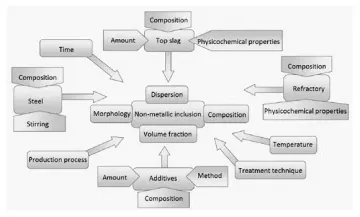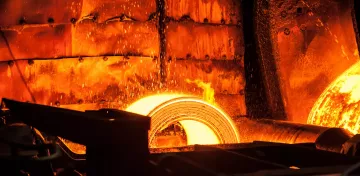Non Metallic Inclusions in Steel: definition, risks, possible solutions
Non metallic inclusions are compound materials, with different chemical origins than the steel, introduced into the steel during the manufacturing process.
It is impossible to manufacture steel that does not contain non metallic inclusions to some extent. These materials also provide different mechanical properties to steel like the corrosion resistance, toughness, formability, etc. at the same time – non metallic inclusions are responsible for defects and failures in steel, however the degree of these effects is yet to be defined. The less are the non metallic inclusions in the steel the better the quality, thus the ability to monitor these inclusions is an important part of the quality control of steel, especially taking into account the array of various important applications steel i (i.e the structural steel is the widest used material for structural framing.
Already in 1918, at a May meeting of the British Iron and Steel Institute, A. McCance presented a study proving that the more defective steel is bad solely due to the concentration of non metallic inclusions it contains, and as high as 90% of the faulty material under this notice, are faulty due to the amount of non metallic inclusions. In 2019, the global structural steel market size reached as high as 290 billion U.S. dollars , and the recent projections show that the size of the structural steel market is expected to top 503.8 Billion U.S. dollars by 2027.
In The US only, 110 million tons of steel is consumed every year, 40 million tons of which is used in the construction industry. (The automotive and the equipment machinery industries are the one following in terms of overall steel consumption). This surely gives the idea of the sheer volumes this material is used in around the globe, and more importantly, the critical applications it is used in.
Non metallic inclusions: basic definitions, causes and classification
The types of the non metallic inclusions in steel depend on various factors such as the steel making process, the treatment and casting of steel, the grade of steel, secondary metallurgy, etc, however there is no particular measure the degree of the inclusions, dependent on these aforementioned factors.

Inclusions with large particles, even if in a small quantity, usually make the steel more defective compared to the ones with larger quantity yet small sizes of the inclusions. Here, another necessity for monitoring not only the content but also the morphology and the distribution of the particles is of utmost importance. ( The cracks on the steel material for example are likely to be passing through groups of inclusions.)
Depending on the source of origin, non metallic inclusions are classified into two groups
- The endogenous inclusions are formed within the metal, due to the chemical processes and within the precipitation of these materials in the liquid phase. These cannot be fully controlled or eliminated, however, through strict control in the forming processes it would be possible to noticeably decrease the volume of these inclusions
- The exogenous inclusions formed due to the entrapment of external non metallic materials (particles of the mould, slag, dust, powders used to protect the steel from sticking in the casting process, etc.). Process control is hereby highlighted, as only through monitoring is it possible to avoid these effects, especially taking into account the overall damage they cause to the quality of the material.
The chemical composition is another method to classify the non metallic inclusions. The most common types of those being oxides, sulfides , carbides, phosphides, nitrides, etc.
The Conventional Methods to detect and control non metallic inclusion
There are different internationally recognized standards that define the acceptable quality of steels, thus also the acceptable amounts and types of inclusions. One of those is the CEN EN 10247 – the Micrographic examination of the non-metallic inclusion content of steels using standard pictures. Over the time the industry has been evolving and changing opinions in terms of how specific should the standards get, as there is not much, clear evidence how “clean” should a steel material be to survive various workloads, this is one of the reasons, for example, why some standards have permitted some percentage of defects above the usually specified limits (i.e the EN 19277–1, standard for bright bars in relation to surface cracks).
The main questions still remain
- How to monitor the quality of steel (in regards to non metallic inclusions especially)?
- How to adapt this process to make it more accessible and trustworthy for the user?
- How to clearly classify the usability of a steel material for applications with different demands?
Direct methods of detection of non metallic inclusions:
these methods are known as more accurate, yet costly and hardly accessible. We will go through some of them below:
- Evaluation of solid steel sections: these are two-dimensional section evaluation methods like Image Analyses, Sulfur Print, Optical emission spectrometry with pulse discrimination analysis (OES-PDA), X-ray photoelectron spectroscopy, etc
- Evaluation of solid steel volumes: These are more likely to provide also three-dimensional information about the inclusions and include the types of detecting like Ultrasonic scanning, Chemical Dissolution, Scanning Acoustic Microscope (SAM), Fractional Thermal Decomposition, Magnetic Particle Inspection, etc.
- Distribution of the inclusion size, after inclusion extraction: After the inclusions are extracted from the steel, some of the above mentioned methods can be used to identify the distribution of the inclusions in a 3D way. I.E. a Coulter Counter Analysis method that uses a sensor with a miniature hole: when the particles get inside the hole they can be detected as across the gap they change the electric conductivity
- Inclusion evaluation: liquid. An example is the Electromagnetic Visualization, Liquid Metal Cleanliness Analyzer(LIMCA), etc.
Indirect methods of detection of non metallic inclusions
These are fast and relatively inexpensive methods, however it comes with the cost, reliability, and the indications are usually relative.
- Measurement using Total Oxygen: then oxygen in steel can be in a form of dissolved oxygen and combined as non metallic inclusion. This method uses the sum of both (the Total Oxygen). As the free/active oxygen has little variation, it is easy to detect this quantity.
- Nitrogen: Nitrogen pickup is an indirect measure of quality problems, total oxygen and steel cleanliness
Is the Non metallic inclusion monitoring stuck?
Today, the modern steel production plants are getting increasingly automated, each parameter is strictly controlled, the conventionally known methods of monitoring the production and post production processes are consolidated by the industry and the best available fit is found per manufacturer. A standard process is to mark an anomalous steel material as “defective” and reject its further use. The thresholds are given by international standards, which as we found are evolving, and yet to fully explore the sector as well.
One thing is clear, neither the available standards, nor the control methods are enough. Even if the controlled parameters are modified and put into the automotion, there is no conventionally available system, simple and elegant enough to showcase the potential defects introduced by the process of steel production itself, or what is not less common, by previous processes (recycled steel materials). The uncertainty of the measures is one side of the issue, the more complicated side of the things is the fact that the available methods cannot perform with the same effectiveness in the extremely variable processes by different manufacturers. The aforementioned material has proven the versatility and complexity of non metallic inclusions, their types, classifications and other affecting factors.
Each of the mentioned methods to identify non metallic inclusions comes with several limitations: the ultrasonic controls for example is not normally useful to detect any defects just below the surface of the steel, Chemical dissolution method is more fitting for a 3D detection, however it also dissolves away FeO, MnO, CaO, MgO in the inclusions, thus is useful for mainly detect Al2O3 and SiO2 inclusions, and is a destructive detection method. Destructive detection methods, in general, are known to be the better options for the final product tests (formability, bending, deep-drawing properties measurement).
RVmagnetics, a company from Slovakia, EU presents an alternative method, that is non-destructive, yet does not compromise the quality of necessary data to be gathered about non metallic inclusions. The technology works on magnetic principles, it is not however, the conventionally known Magnetic Principle Inspection method (direct), which locates inclusions larger than 30µm, the system has a different logic, is elegant, simple, and most importantly precise.
Essentially the solution consists of MicroWire sensors and the sensing system . The MicroWire sensors are able to detect all inclusions, including the inner ones (this opens an opportunity to detect internal cracks or other anomalies that occur during the operation of the steel material as well). The magnetic principle used to receive the valuable data is rather unique and unlike other conventionally available systems.
Detection and tagging:
The solution consists of two checkpoint MicroWire lines installed on the steel, excitation coil – which creates the magnetic field going through the sensor, and another, sensing coil – which detects the response from MicroWire. When the magnetic field is excited, once a non-magnetic inclusion(or a scratch, crack, deformations both on surface and inner inclusion) occurs a sharp signal can be obtained. A dedicated software receiving the signal at full production speed, can quickly ensure the marking of the spots where the MicroWire sensor detected the non metallic inclusion or any other anomalies. Our focus within the industry is currently put on the Cold rolled steel sheets manufacturing), and even though there is a substantial amount of research and development to be done in exploration of the industry, signal detection and non metallic inclusions measurement in various shapes and types of steels – our solution is essential and unique in performance.
The RVmagnetics task is to customize the solution according to the demand from the customer, the sensors are inexpensive to produce, the company has no issues with the scalability and is ready for business . Especially now, when the market observations clearly designate the need for a physical data production unit that is simple, yet precise enough to be accessible for manufacturers of all sizes, and to be used for the necessary R&D to increase the certainty of international standards for different uses of steel materials.




